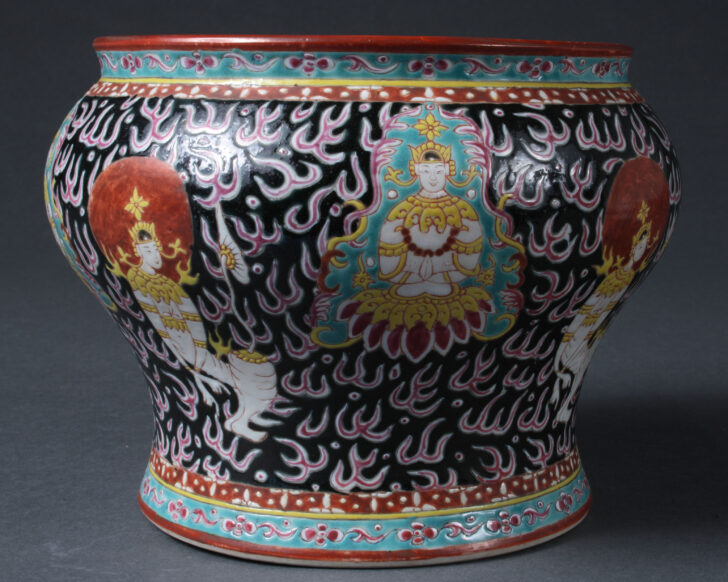Bencharong Ware Spitton with Buddhist dieties Thapanom and Norasingh, and Chinese fire patterns
Chinese

Description
March 28, 2009
Bencharong is a type of overglazed, multicolored enamel porcelain produced in Jingdezhen, the epicenter of Chinese ceramic production, for the Thai market. Bencharong means “five coloring” in Sanskrit and relates to the mystical number five in the Hindu and Buddhist religions. A variety of shapes and designs were made for Thai royalty as well as for the general public; often Thai artisans were sent with royal orders to Jingdezhen, to ensure that the Chinese potters followed the specified designs.
Spittoons were among the paraphernalia used for betel-nut chewing. This spittoon has the design of Thepanom and Norasingh, minor Buddhist deities popular in Thailand. Thepanom, usually shown praying, are celestial beings who live in one of the six lower heavens of Buddhist cosmology. Norasingh, a type of Thepanom, is a half-human, half-lion creature, embellished with a flame, with a fire-tipped tail and the hoofs of a deer. Norasingh may be a Thai adaptation of the Indian Narasingh, who has a man’s body and a lion’s head and is one of the reincarnations of the god Vishnu. Norasingh motifs are used only on royal wares and probably symbolize the king’s divinity.
(Label for UMMA South and Southest Asia Gallery Opening Rotation, March 2009)
Subject Matter:
Spittoons were used by chewers of betel nut chewing, a common custom in Thai and other Southeast Asian countries. The spittoon shape is considered Thai, since they were probably ordered by the Thai and were rarely made for use in China. This spittoon has the design of Thepanom and Norasingh, minor Buddhist deities popular in Thai since around late 17th and early 18th century. Thepanom, usually in praying posture, are celestial beings who live in one of the six lower heavens of Buddhist cosmology. Norasingh, a type of Thepanom associated with the Himaphan forest, a mythical woods located in the Himalayan mountains below the heavens of the gods. A Norasingh has a human head, torso, and arms ornamented in the same fashion as the Thepanom; the hindquarters of a lion embellished with a flame; a flame-tipped tail and the hoofs of a deer. The Norasingh may be a Thai adaptation of the Indian Narasingh, who has a man’s body and a lion’s head and is one of the reincarnations of the god Vishnu. Norasinghs are used only on royal wares and probably symbolize the king’s divinity. On Bencherong ware, Norasingh are shown with one hand laid across the other, possibly a prayer attitude, and with red halos.
Physical Description:
Bencharong ware spittoon made in a private kiln in Jingdezhen, China, for Thai market. Probably ordered from Thai royalty, under the reign of Rama II (r. 1809-1824). It is the porcelain ware enameled with multiple colors, in the style called “five colors” (“bencharong” refers to five colors in Sanskrit). It has a large mouth and bulbous shape, with design of minor Buddhist deities Thepanom and Norasingh, and Chinese fire patterns.
Usage Rights:
If you are interested in using an image for a publication, please visit https://umma.umich.edu/request-image/ for more information and to fill out the online Image Rights and Reproductions Request Form.